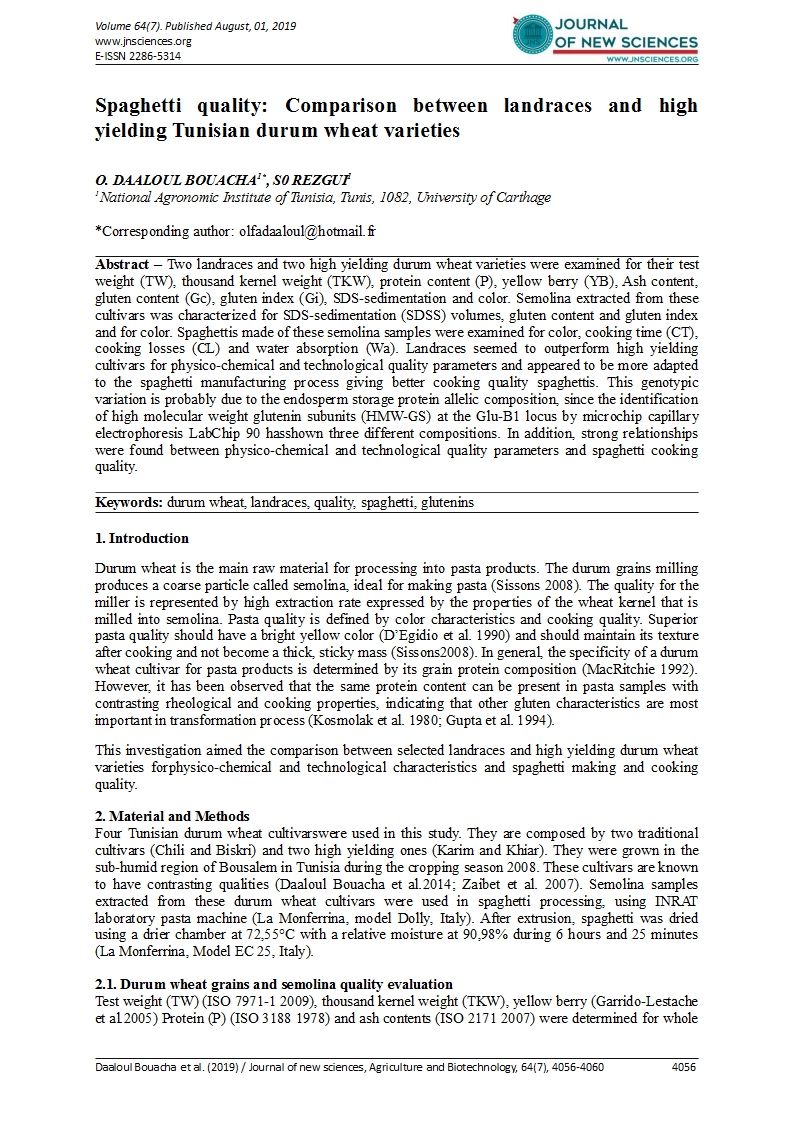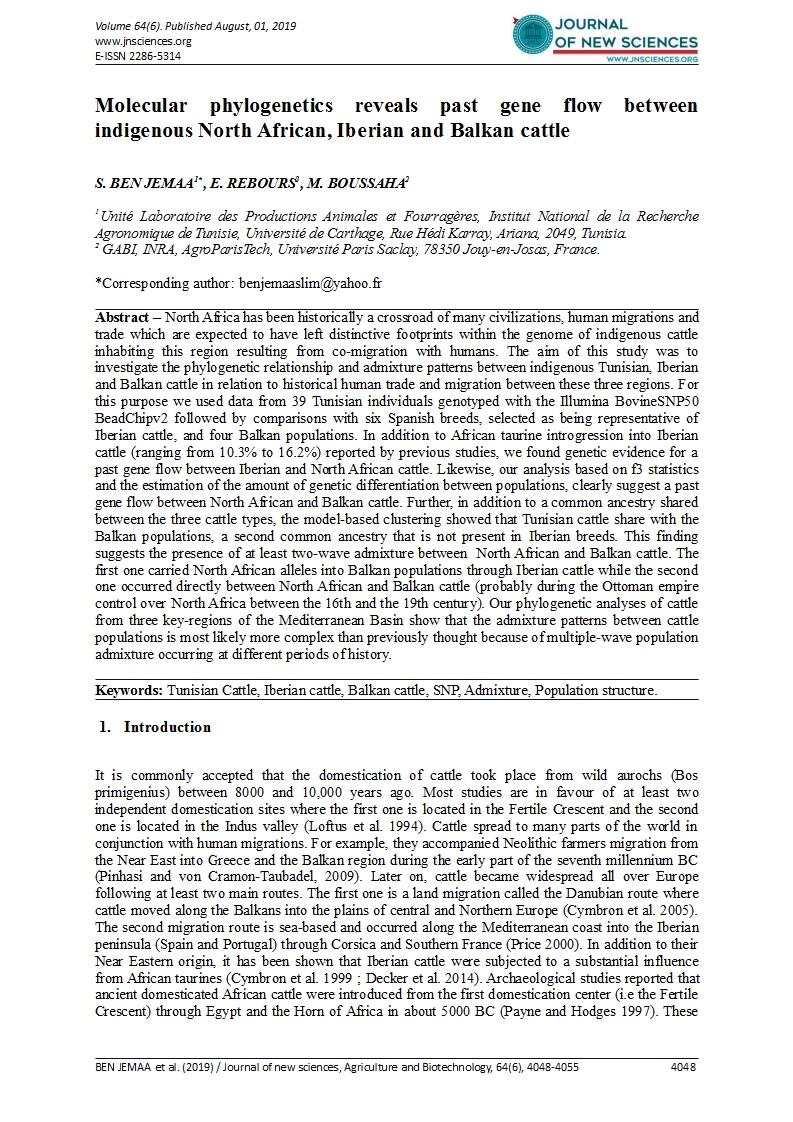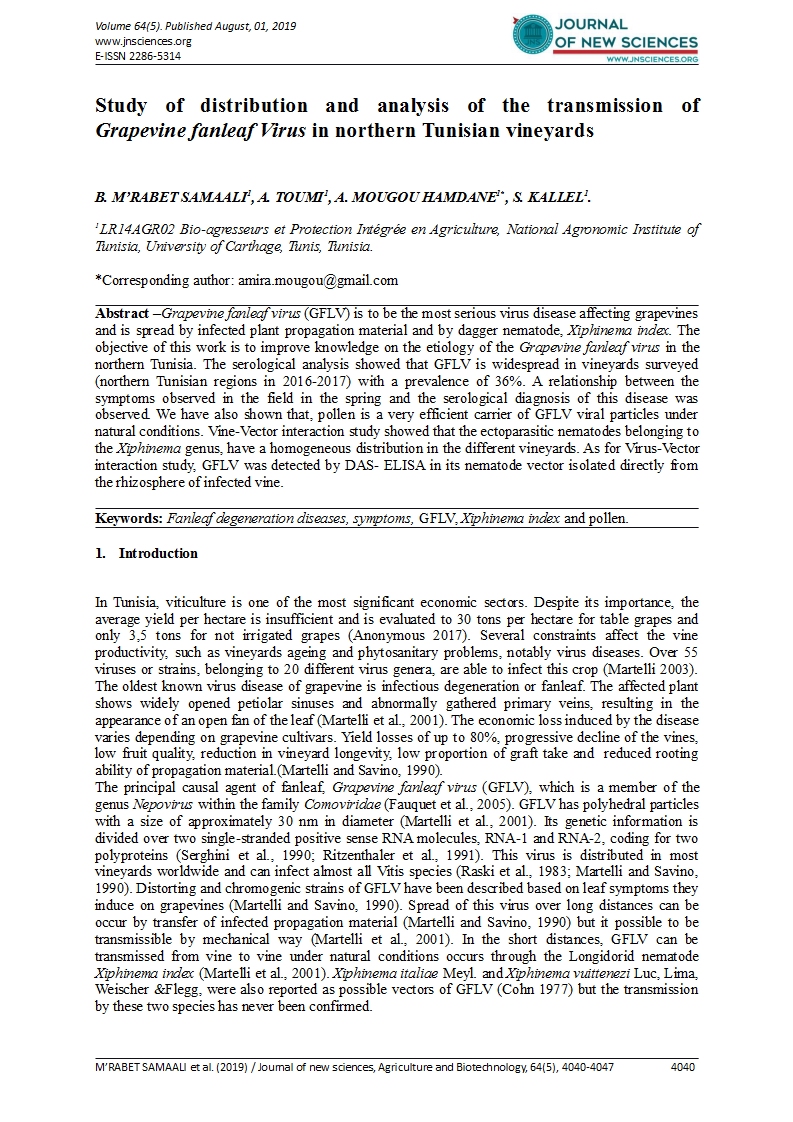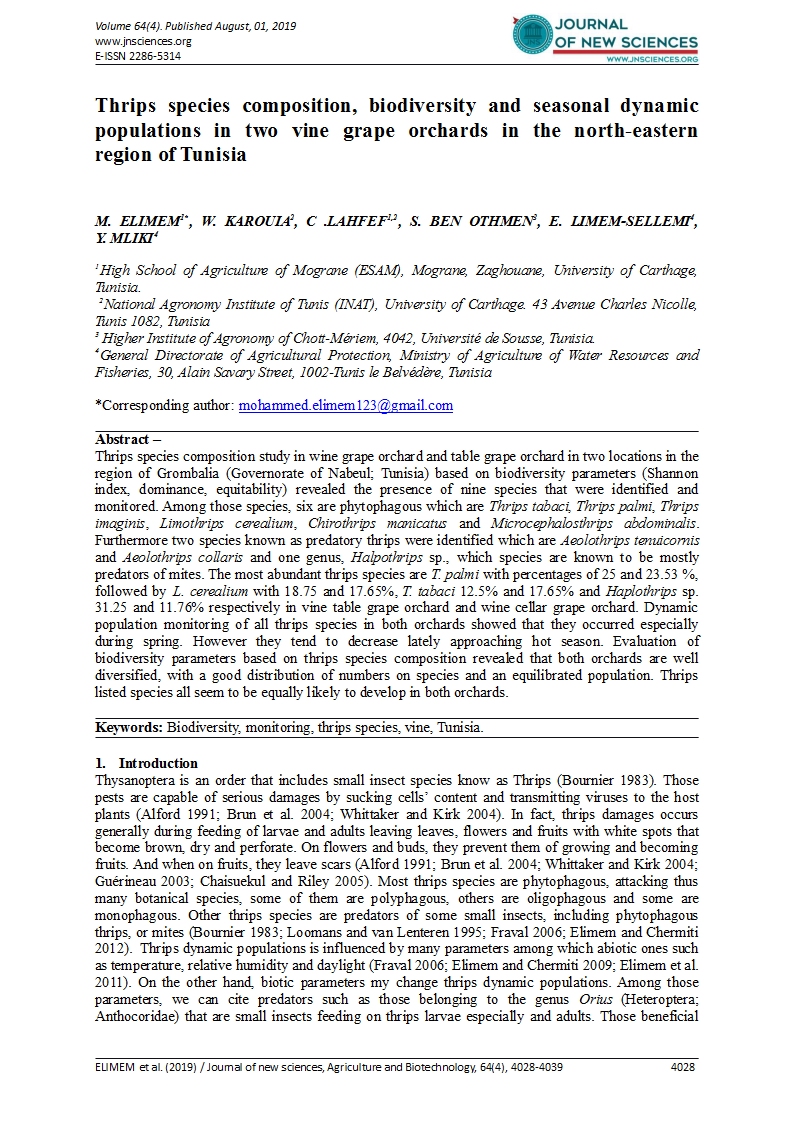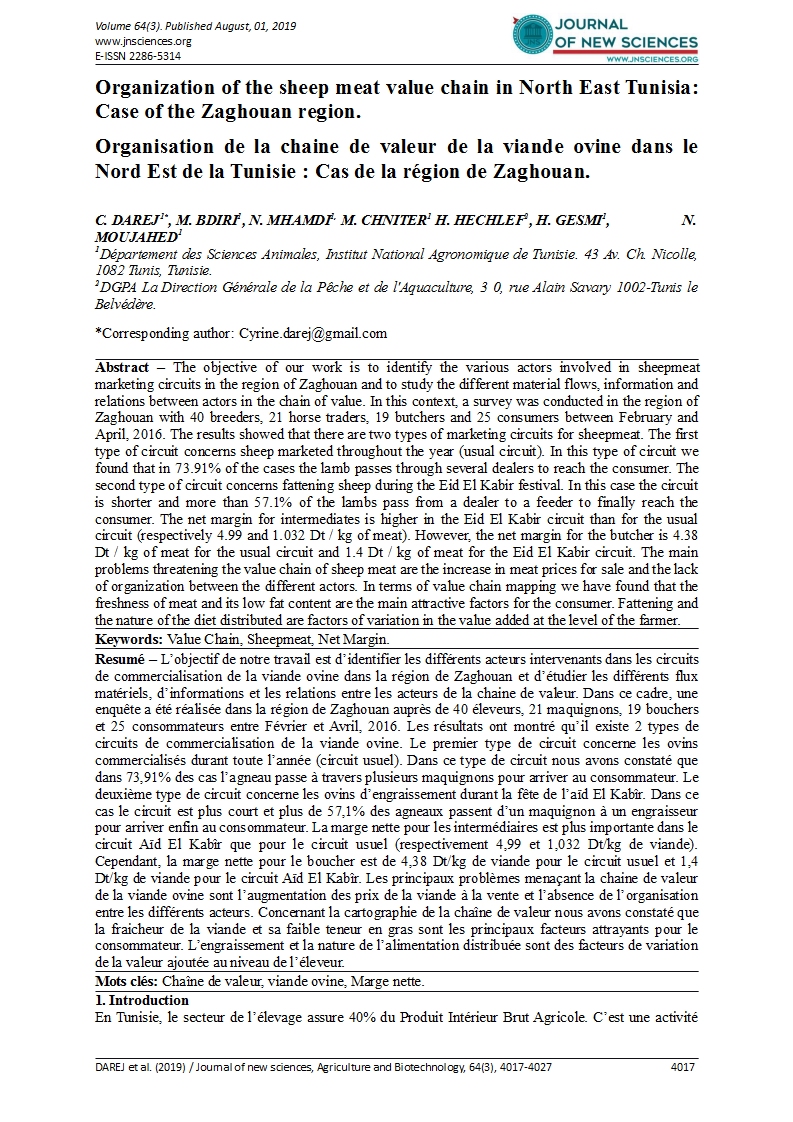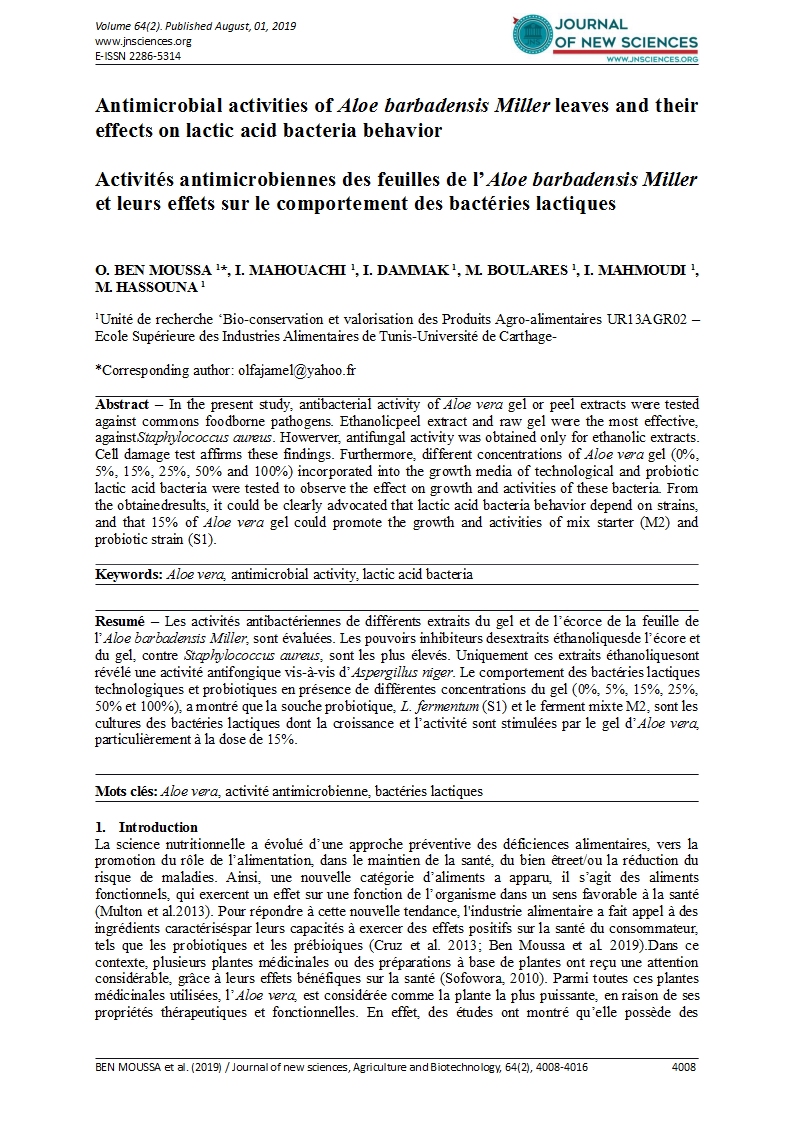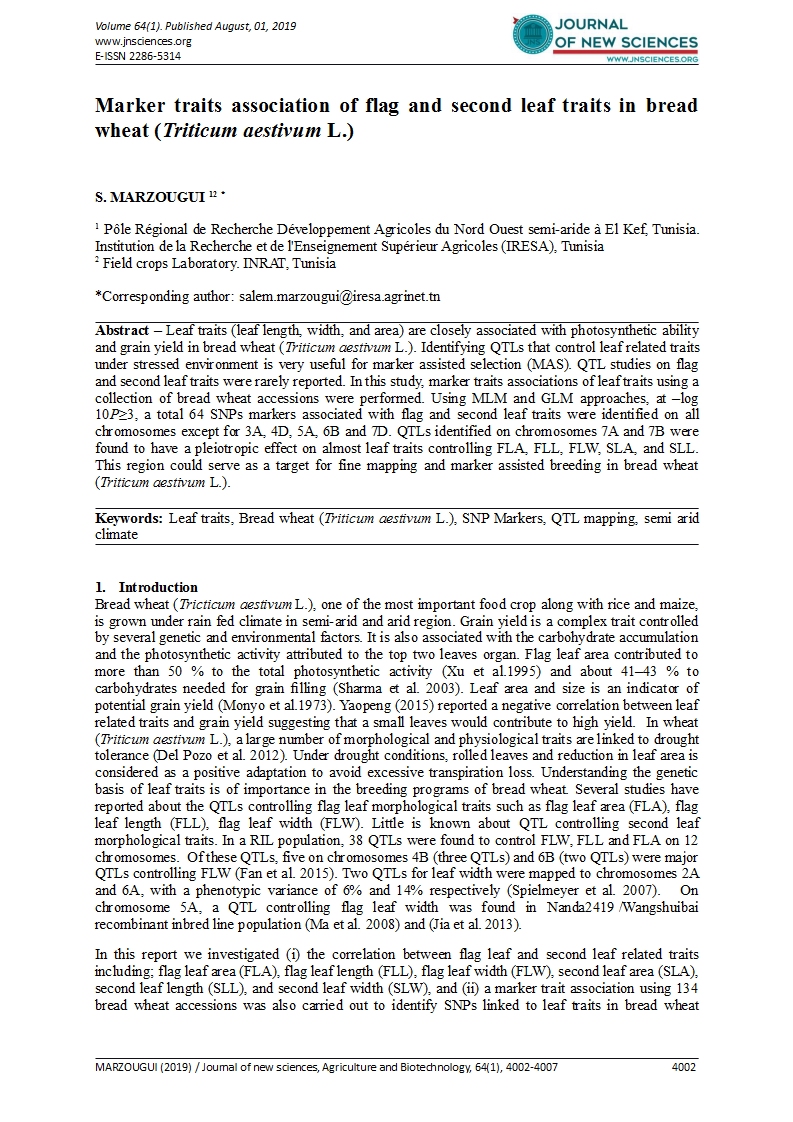M. ELIMEM1*
W. KAROUIA2
C .LAHFEF1,2
S. BEN OTHMEN3
E. LIMEM-SELLEMI4
Y. MLIKI4
1High School of Agriculture of Mograne (ESAM), Mograne, Zaghouane, University of Carthage, Tunisia.
2National Agronomy Institute of Tunis (INAT), University of Carthage. 43 Avenue Charles Nicolle, Tunis 1082, Tunisia
3 Higher Institute of Agronomy of Chott-Mériem, 4042, Université de Sousse, Tunisia.
4General Directorate of Agricultural Protection, Ministry of Agriculture of Water Resources and Fisheries, 30, Alain Savary Street, 1002-Tunis le Belvédère, Tunisia
Abstract –
Thrips species composition study in wine grape orchard and table grape orchard in two locations in the region of Grombalia (Governorate of Nabeul; Tunisia) based on biodiversity parameters (Shannon index, dominance, equitability) revealed the presence of nine species that were identified and monitored. Among those species, six are phytophagous which are Thrips tabaci, Thrips palmi, Thrips imaginis, Limothrips cerealium, Chirothrips manicatus and Microcephalosthrips abdominalis. Furthermore two species known as predatory thrips were identified which are Aeolothrips tenuicornis and Aeolothrips collaris and one genus, Halpothrips sp., which species are known to be mostly predators of mites. The most abundant thrips species are T. palmi with percentages of 25 and 23.53 %, followed by L. cerealium with 18.75 and 17.65%, T. tabaci 12.5% and 17.65% and Haplothrips sp. 31.25 and 11.76% respectively in vine table grape orchard and wine cellar grape orchard. Dynamic population monitoring of all thrips species in both orchards showed that they occurred especially during spring. However they tend to decrease lately approaching hot season. Evaluation of biodiversity parameters based on thrips species composition revealed that both orchards are well diversified, with a good distribution of numbers on species and an equilibrated population. Thrips listed species all seem to be equally likely to develop in both orchards.
Keywords: Biodiversity, monitoring, thrips species, vine, Tunisia.
-
Introduction
Thysanoptera is an order that includes small insect species know as Thrips (Bournier 1983). Those pests are capable of serious damages by sucking cells’ content and transmitting viruses to the host plants (Alford 1991; Brun et al. 2004; Whittaker and Kirk 2004). In fact, thrips damages occurs generally during feeding of larvae and adults leaving leaves, flowers and fruits with white spots that become brown, dry and perforate. On flowers and buds, they prevent them of growing and becoming fruits. And when on fruits, they leave scars (Alford 1991; Brun et al. 2004; Whittaker and Kirk 2004; Guérineau 2003; Chaisuekul and Riley 2005). Most thrips species are phytophagous, attacking thus many botanical species, some of them are polyphagous, others are oligophagous and some are monophagous. Other thrips species are predators of some small insects, including phytophagous thrips, or mites (Bournier 1983; Loomans and van Lenteren 1995; Fraval 2006; Elimem and Chermiti 2012). Thrips dynamic populations is influenced by many parameters among which abiotic ones such as temperature, relative humidity and daylight (Fraval 2006; Elimem and Chermiti 2009; Elimem et al. 2011). On the other hand, biotic parameters my change thrips dynamic populations. Among those parameters, we can cite predators such as those belonging to the genus Orius (Heteroptera; Anthocoridae) that are small insects feeding on thrips larvae especially and adults. Those beneficial insects are present in nature and are even employed in biological control and integrated pest management to control thrips populations (Loomans and van Lenteren 1995; Parker et al. 1995; Elimem and Chermiti 2012; Elimem et al. 2018.a).
The aim of this work is to study different thrips species biodiversity and dynamic populations in two vine grape orchards in the north-eastern region of Tunisia.
2. Materials and Methods
2.1 Experimental site
This work was carried from March 16th to June 03rd 2016 in two vine grape orchards; table vine grape and wine cellar grape. Both orchards are situated in the region of Grombalia (36°36’51’’ N, 10°25’38” E) belonging to the governorate of Nabeul in Tunisia (Figure 1).
|

|
|
Figure 1. Geographical localization of the experimental site.
|
Both orchards are characterized by a clay-limestone soil. Vine table orchard has an area of 0.5 ha and conducted in pergola mode with the Muscat grape of Italy. This variety is characterized by golden yellow fruits, very sweet and of a musky flavor. Regarding wine cellar grape orchard, it has an area of 1 ha and planted in Pergolette mode by the Syrah grape variety which has black fruits.
2.2. Sampling
Sampling was done weekly and randomly from each orchard since leaves appearance on March 16th 2016. In each orchard, fifty vine plant were chosen randomly and divided into three strata; upper, medium and bottom. From each stratum, one leaf is sampled making thus a total number of 150 sampled leaves from each orchard. Samples were placed in plastic bags and taken to the laboratory.
2.3. Thysanoptera fauna identification
All collected thrips specimens were mounted according to the method described by Bournier (1983) and identified lately according to the identification keys of Mound et al. (1976), Mound and Walker (1982), Brodsgaard (1989), Palmer et al. (1989), Mound and Kibby (1998) and EPPO (2002).
2.4. Biodiversity study of Thysanoptera fauna
According to Roger (1977), indices of the diversity of a population represent the amount of information represented by a given sample on how individuals are distributed among various species. In this way, changes in diversity indices of samples from the same population spread over time give an idea about the changing structure of the population and monitoring its evolution.
Among the studied parameters to get an idea about the diversity of a population, we find species richness which is the number of recorded species in a habitat. The index of Shannon or Shannon-Weaver is used to evaluate the spatial and temporal diversity in a habitat or set of habitat (Roger 1977) stands. This index is calculated using the following formula:
H’= - 
Where H’ is the Shannon biodiversity index, i is the species of the studied site, Pi is the proportion of species i relative to the total number of species (S) in the study areas, knowing that Pi = ni / N where ni is the number of individuals of species I, and N is the total number of all species. It should be noted that this parameter, in nature, is generally between 0.5, which indicates a very low diversity, and 4.5.
The other parameters that have been measured are dominance and equitability. The first is expressed by:D = n x 100 / N
Where D is the dominance, n is the number of individuals belonging to the species best represented and N is the total number of individuals in a given sample.
Concerning equitability, it is the ratio of the actual diversity observed at the theoretical maximum diversity. Similarly, equitability clarifies the structure of the ecosystem. It is expressed by the following formula:E = H’/Ln N
This parameter varies between 0 and 1; it tends to 0 when almost all the encountered individuals are concentrated on a single species and therefore it is the most dominant, and tends to 1 when all species have the same abundance and in this case they are equitably distributed and the population is homogeneous across all species. In addition, a number of less than 0.6 fairness characterizes a turbulent environment (Roger 1977; Graham et al.2009).
All these parameters were measured using the software PAST® (Paleontological Statistics).
On the other hand, thrips species were classified according their dominance into the following groups according to Kucharczyk et al. (2011) and Elimem et Chermiti (2013); eudominants (> 10%), dominants (5.1 to 10%), subdominants (2.1 to 5%), recedents (1 to 2%) and subrecedents (lower than 1%).
3. Results and Discussion
-
Identification and listing of thrips species encountered in both vine grape orchards
During the entire monitoring period, a total of 25 specimens were collected from grape vine sampled leaves. According to the identification keys, a total of 6 genera and 9 species of phytophagous and predatory thrips have been identified. Thrips species identified are listed in table 1.
|
Table 1. Thrips species encountered in both vine grape orchards.
|
|
Order
|
Subordre
|
Family
|
Genus
|
Species
|
|
Thysanoptera
|
Tubulifera
|
Phlaeothripidae
|
Haplothrips
|
spp.
|
|
|
|
Aeolothripidae
|
Aeolothrips
|
tenuicornis Bagnall (1926)
|
|
|
|
|
|
collaris Priesner (1919)
|
|
|
Terebrantia
|
Thripidae
|
Chirothrips
|
manicatus Haliday (1836)
|
|
|
|
|
Limothrips
|
Cerealium Haliday (1836)
|
|
|
|
|
Microcephalosthrips
|
abdominalis Crawford (1910)
|
|
|
|
|
Thrips
|
palmi Karny (1925)
|
|
|
|
|
|
imaginis Bagnall (1926)
|
|
|
|
|
|
tabaci Lindemann (1889)
|
In the table grape orchard, most important species were those belonging to the genius Haplothrips spp. that represent a percentage of about 31.25 % of the total population found, followed by Thrips palmi with 25% then Limothrips cerealium with 18.75%. In regards to the wine grape orchard, the highest percentages were observed with the species Thrips palmi with 23.53%, followed by Thrips tabaci and Limothrips cerealium with equal percentages of about 17.65% (Table 2). On the other hand, the thrips species were classified according to Kucharczyk et al. (2011) into the following groups: eudominants (> 10%), dominants (5.1 to 10%), subdominants (2.1 to 5%), recedents (1 to 2%) and subrecedents (lower than 1%). Obtained results (Table 2), showed that T. palmi, L. cerealium, T. tabaci and Haplothrips spp. are all eudominant species, meaning thus that they were the most abundant and the most encountered species in both orchards. Regarding the rest of identified species, they were even dominant or absent such as T. imaginis, Ae. collaris, Ae. tenuicornis, M. abdominalis and Ch. Manicatus.
|
Table 2. Thrips species composition collected in both vine grape orchards.
|
|
|
Table vine orchard
|
Wine cellar grape orchard
|
|
Species
|
Number
|
Percentage (%)
|
Dominance
|
Number
|
Percentage (%)
|
Dominance
|
|
Thrips palmi
|
4
|
25
|
+ + + + +
|
4
|
23.52
|
+ + + + +
|
|
Limothrips cerealium
|
3
|
18.75
|
+ + + + +
|
3
|
17.64
|
+ + + + +
|
|
Thrips tabaci
|
2
|
12.5
|
+ + + + +
|
3
|
17.64
|
+ + + + +
|
|
Haplothrips spp.
|
5
|
31.25
|
+ + + + +
|
2
|
11.76
|
+ + + + +
|
|
Thrips imaginis
|
0
|
0
|
-
|
1
|
5.88
|
+ + + +
|
|
Aeolothrips collaris
|
1
|
6.25
|
+ + + +
|
1
|
5.88
|
+ + + +
|
|
Aeolothrips tenuicornis
|
0
|
0
|
-
|
2
|
11.76
|
+ + + +
|
|
Microcephalothrips abdominalis
|
1
|
6.25
|
+ + + +
|
0
|
0
|
-
|
|
Chirothrips manicatus
|
0
|
0
|
-
|
1
|
5.88
|
+ + + +
|
|
Total
|
16
|
-
|
-
|
17
|
-
|
-
|
Legend: (+ + + + +): Eudominant, (+ + + +): Dominant, (+ + +): Sub-dominant, (+ +) Recedent, (+): Subrecedent.
-
Thrips populations’ monitoring
Monitoring of thrips populations shows the succession of two peaks (Figure 2). The first marks the first generation of individuals that had restarted their activity after the winter rest. The second most important peak was observed on May 04th 2016 with a total thrips number of about 11 individuals which corresponds to the proliferation of thrips with host plant leaf staggering. In fact, it seems that the evolution of thrips on vine orchards is intimately related to the phenological stages of the host plant. Those results concord with those listed by Elimem and Chermiti (2009) in a rose crop greenhouse and Elimem and Chermiti (2013) in citrus orchards, Elimem et al. (2011) and Elimem et al (2018.a) in pepper crop green houses, were thrips species compositions follow the phenological parameters of the host plants. On the other hand, Elimem and Chermiti (2009), Elimem et al. (2011) and Elimem et al. (2018.a, 2018.b), indicated that host plants phenological parameters modulate thrips dynamic populations, their distribution in the host plant different parts, reproduction and even the sex-ratio.
|

|
|
Figure 2. Thrips species monitoring in both orchards in the region of Grombelia.
|
-
Biodiversity parameters
Monitoring thrips species populations and evaluation of biodiversity indexes (Figure 3) and parameters showed that both orchards are characterized by a good diversity which is due to a Shannon indexes exceeding 1.4 (Jayaraman 1999). In fact, it seems that the limited treatments that the table grape orchard receives, and the total absence of chemical interventions in the wine grape orchard in the other hand, are the origin of these values. Despite the difference between Shannon indexes in both orchards, these values show no significant differences. On the other hand, indexes of dominance and equitability showed a good distribution and repartition of species numbers in both orchards. In fact, analyzing equitability index showed that it tends to 1 in both orchards which shows that all species have the same abundance and in this case they are equitably distributed and the population is homogeneous across all species.
|

|
|
Figure 3. Biodiversity parameters and indexes in both grape vine orchards in the region of Grombelia in 2016.
|
-
Thrips species monitoring
-
Thrips palmi Karny (1925) (Thysanoptera ; Thripidae)
That eudominant species was found with 25% and 23.53% in table grape orchard and wine grape orchard respectively. This species is found in various tropical regions, in Africa and Asia. Furthermore, it has been reported in Australia, Central America and some European countries(Lacasa and Llorens 1996; Palmer et al. 1989). According to Mani et al. (2014) this species has only been reported on grapevine orchards in India. These results indicated that it is reported for the first time in Tunisia in grape orchards.
Monitoring T. palmi populations (Figure 4) showed that this species appeared from March and continue its gradual increase as to the summer season. Indeed, this is coherent to the results cited by Nagai (1993), Lakshmi et al. (1993) and Lacasa and Llorens (1996) who reported that T. palmi has an optimum of its biotic potential at an average temperature of 25°C. T. palmi numbers tend to increase as the phenological state of the host plant improves (Lacasa et Llorens 1996) which is coherent with results cited in this study.
|

|
|
Figure 4. T. palmi in both grape vine orchards in the region of Grombelia
|
-
Limothrips cerealium Haliday (1836) (Thysanoptera ; Thripidae)
This second eudominant species is ubiquitous in the two plots with respective percentages of 18.75 and 17.65% for table grape orchard and wine grape orchard. It has been reported on several host plants such as cereals, citrus and grapevine orchards (Mound et Walker 1982; Navarro et al. 2008; Trabelsi et Boulahia-Kheder 2009; Belaam et Boulahia-Kheder 2012).
This species begins to appear in April, decreases thereafter than rises in the wine grape orchard towards the end of the period of this study (Figure 5).
|

|
|
Figure 5. L. cerealium in both grape vine orchards in the region of Grombelia.
|
In citrus orchards, Navarro et al. (2008) in Spain and Elimem and Chermiti (2013) in Tunisia, recorded that in spite of the presence of this species on this host plant but no high numbers were recorded and its appearance starts during January and increases slightly in April and May. Same results were mentioned by Goldarazena (1996) in cereal crops in Spain.
-
Haplothrips spp. Amyot and Serville (1843) (Thysanoptera ; Phlaeothripidae)
In the two orchards eudomiants species belonging to the genus Haplothrips spp. were found. However, this species was more abundant at the table grape orchard than the wine grape orchard. Most of these species live on Asteraceae, Poaceae, Chenopodiaceae or other plants such as citrus grapevine and rose(Palmer et Mound 1990; Zur Strassen 1995; Kakimoto et al. 2006; Okajima 2006; Elimem 2008; Minaei et Mound 2008; Belaam et Boulahia-Kheder 2012).
Monitoring of Haplothrips spp. has shown that this species complex begins to appear on mid-April in the vine table orchard. While, in the wine cellar grape orchard only one peak was observed during the end of May. Indeed, according to Larsson (2005), populations of Haplothrips sp. have their proliferation from the end of May and during the month of June. Similarly, Elimem (2008) mentions that populations of Haplothripsvictoriensis on rose crops and in Tunisian conditions, start to appear from April to peak in June and decline in July.
|

|
|
Figure 6. Haplothrips spp.in both grape vine orchards in the region of Grombelia.
|
3.4.4. Thrips tabaci Lindemann (1889) (Thysanoptera; Thripidae)
T. tabaci is a cosmopolitan and polyphagous thrips species that can attack more than 150 botanical species (Mound and Walker 1982; Lacasa and Llorens 1996) such as citrus and grapevine (Teksim and Tunç 2009; Elimem and Chermiti 2013).
This eudominant species appears from the beginning of the study period at the table grape orchard, and increased thereafter during April and May in both orchards (Figure 7).
|

Figure 7. T. tabaci in both grape vine orchards in the region of Grombelia.
|
Navarro et al. (2008) mention that in Spain and on citrus orchards T. tabaci begin to proliferate on February. It reaches the maximum of its populations on end of March and April and starts to regress from June. Same results were mentioned in Tunisia by Elimem and Chermiti (2013) in citrus orchards. This may be confirmed by Waiganjo et al. (2008) who indicated that T. tabaci populations in high temperatures and low relative humidity start to increase while high relative humidity decreases this pest numbers.
-
Thrips imagines Bagnall (1926) (Thysanoptera ; Thripidae)
This species was absent at the table vine orchard and occurred only with one individual in the wine cellar grape orchard during the first week of our study (Figure 8). This species cannot persist on crops in the absence of flowers, which may explain its disappearance in the wine grape orchard during the rest of the study (Lacasa and Llorens 1996; Funderberk 2001).
|

Figure 8. T. imaginis in both grape vine orchards in the region of Grombelia.
|
-
Microcephalothrips abdominalis Crawford (1910) (Thysanoptera ; Thripidae)
Results found showed that this species was present only at the table grape orchard with only one individual and a percentage of 6.25% (Figure 9).
Mound and Walker (1982) indicate that in Australia specimens of this species are collected during February and March. However, and during this this study, M. abdominalis showed a later appearance during May with a very small population. This species is reported on different host plants.
|

Figure 9. M. abdominalis in both grape vine orchards in the region of Grombelia
|
3.4.7. Chirothrips manicatus Haliday (1836) (Thysanoptera; Thripidae)
C. manicatuswas manifested with a single individual at the wine grape orchard (Figure 10). According to Minaie and Mound (2010) and Mound and Palmer (1972), species of the genus Chirothrips develop mainly on the Poaceae family. As a result, its presence on vine orchards can be accidental due to the presence of several weeds all around the crop. Besides, C. manicatus was reported for the first time in Tunisia in 2018 by Elimem et al. (2018.c) on grape vine orchard.
|

|
|
Figure 10. Ch. manicatus in both grape vine orchards in the region of Grombelia.
|
-
Aeolothrips spp. Haliday (1836) (Thysanoptera ; Aeolothripidae)
Two species of predatory thrips were also recorded. Indeed, Ae. tenuicornis and Ae. collaris. Obtained results show sed that Ae. tenuicornis was present only in the wine grape orchard and only occurred once during May. Ae. Collaris was present in both orchards with lower numbers during the beginning and end of April (Figure 11).
According to Navarro et al. (2008) and Elimem and Chermiti (2013), the species of Aeolothrips begin their evolution from February and March to reach their maximum towards the beginning of April. The difference with the present study is that Ae. collaris made its appearance in April while Ae. Tenui cornis did not manifest until May.
|

Figure 11. Aeolothrips in both grape vine orchards in the region of Grombelia.
|
4. Conclusion
During an inventory and monitoring of thrips species in two grape vine orchards in the region of Grombelia in Tunisia, nine thrips species were recorded and identified among which Thrips tabaci, Thrips palmi, Thrips imaginis, Limothrips cerealium, Chirothrips manicatus and Microcephalosthrips abdominalis that are phytophagous thrips species, and two species of predatory thrips belonging to the genus Aeolothrips; Ae. Collaris and Ae. Tenuicornis. The genus Haplothrips was also encountered. Study of thrips species compositions in relation with biodiversity parameters and indexes indicated that the grape vine orchards are characterized by a good diversity, equitability and abundance due to the absence of chemical treatments. Monitoring all thrips species populations allowed to know critical appearance periods of each species. Those results allowed to establish an adequate integrated pest management on the future based on these results.
5. References
Alford DV (1991) Atlas en couleur. Ravageurs des végétaux d'ornement: Arbres-Arbustes-Fleurs. INRA Editions, Paris.
Bournier A (1983) Les Thrips. Biologie, Importance Agronomique. INRA, Paris.
Brun R, Bertaux F, Metay C, Blanc ML, Widzienkonsji C, Nuee N (2004) Stratégie de protection intégrée globale sur rosier de serre. PHM – Revue Horticole 461 : 23-27.
Brodsgaard HF (1989)Frankliniella occidentalis (Thysanoptera; Thripidae) – a new pest in Danish glasshouses, A review, Frankliniella occidentalis (Thysanoptera; Thripidae)- et nyt skadedyr I danske voeksthuse, En litteraturgennemgang. Tidsskr. Planteavl. 93: 83-91 p.
Chaisuekul C, Riley DG (2005) Host plant, temperature, and photoperiod effect on ovipositional preference of Frankliniella occidentalis and Frankliniella fusca (Thysanoptera: Thripidae). Journal of Economic Entomology 98(6): 2107-2113.
Elimem M (2008)Contribution à l’étude de la dynamique des populations de Frankliniella occidentalis Pergande (1895) (Thysanoptera: Thripidae) sur une culture protégée de rosier dans la région de Sahline. Master. 115 p.
Elimem M, Chermiti B (2009) Population Dynamics of Frankliniella occidentalis Pergande (1895) (Thysanoptera: Thripidae) and Evaluation of its Different Ecotypes and their Evolution in a Rose (Rosa hybrida) Greenhouse in the Sahline Region, Tunisia . The African Journal of Plant Science and Biotechnology. Special Issue 1 2009 Tunisian Plant Science and Biotechnology I. 3, 53-62.
Elimem M, Harbi A, Chermiti B (2011) Dynamic population of Frankliniella occidentalis Pergande (1895) (Thysanoptera: Thripidae) in a pepper crop greenhouse in the region of Moknine (Tunisia) in relation with environmental conditions. The African Journal of Plant Science and Biotechnology 5 (1): 30-34.
Elimem M, Chermiti B (2012) Use of the predators Orius laevigatus and Aeolothrips spp. to control Frankliniella occidentalis populations in greenhouse peppers in the region of Monastir, Tunisia. Integr Control Prot Crops Mediterr Clim IOBCWPRS Bull 80:141–146.
Elimem M, Chermiti B (2013) Thrips species composition and seasonal dynamic populations in an organic Citrus orchard in the Central Eastern coast of Tunisia. IOBC WPRS Integrated Control in Citrus Fruit Crops. IOBC-WPRS Bulletin. 95: 77-82.
Elimem M, Harbi A, Limem-Sellemi E, Ben Othmen S, Chermiti B (2018.a) Orius laevigatus (Insecta; Heteroptera) local strain, a promising agent in biological control of Frankliniella occidentalis (Insecta; Thysanoptra) in protected pepper crops in Tunisia. Euro-Mediterranean Journal for Environmental Integration. 3(5) : 2-6.
Elimem M, Harbi A, Hafsi A, Ben Othmen S, Lahfef C, Limemsellemi ., Abbes K, Chermiti B. (2018.b.) Within plant vertical distribution of Frankliniella occidentalis Pergande (1895) (Thysanoptera; Thripidae) on greenhouse pepper crop: effects of climatic conditions and implications for populations surveillance and control programs. Journal of new sciences, Sustainable Livestock Management, 6 (3), 124-135.
Elimem M, Harbi A, Hafsi A, Ben Othmen S, Limem-Sellemi E, Michel B, Chermiti B. (2018.c.)Frankliniella occidentalis (Thysanoptera; Thripidae) sex-ratio evaluation in pepper crop greenhouses in relation with biotic and abiotic parameters. Journal of new sciences, Agriculture and Biotechnology, 49(5): 2979-2991.
EPPO (2002)Frankliniella occidentalis, Diagnostic protocols for regulated pests Protocoles de diagnostic pour les organismes réglementés, European and Mediterranean Plant Protection Organization, Organisation Européenne et Méditerranéenne pour la Protection des Plantes. Bulletin OEPP/EPPO Bulletin 32: 281–292 p.
Fraval A (2006) Les Thrips. Insectes 143 : 29-34.
Funderberk J. (2001)Ecology of thrips. Thrips and tospovirusus: proceedings of the international symposium on Thysanoptera. Reggio Calabria, Italy, from the 2-7th of July 2001 Proceeding: 121-128 p.
Graham JH, Kryzsik AJ, Kovacic DA, Duda JJ, Freeman DC, Emlen JM, Zak JC, Long WR, Wallace MP, Chamberlin-Graham C, Nutter JP, Balbach HE (2009) Species richness, equitability and abundance of ants in disturbed landscapes. Ecological Indicators 9: 866-877 p.
Guerineau C (2003) La culture du fraisier sur substrat. Ctifl. Centre Technique Interprofessionnel des Fruits et Légumes. Ed. CTIFL. Et CIREF. Centre technique interprofessionnel des fruits et légumes. Paris.
Goldarazena A (1996) Contribucion al conocimiento de los tisanopteros de Navarra (clase insecta, orden thisanopteros). Thesis Doctoral. Universidad de Navarra, Facultad de Ciencias. Departamento de Zoologia y Ecologia. Espana. Spain.
Kakimoto K, Inoue H, Hinomoto N, Noda T, Hirano K, Kashio T, Kusigemati K, Okajima S (2006)Potential of Haplothrips brevitubus (Karny) (Thysanoptera: Phlaeothripidae) as a predator of mulberry thrips Pseudodendrothrips mori (Niwa) (Thysanoptera: Thripidae). Biological Control 37: 314–319 p.
Kucharczyk H, Pawel KB, Dobrowski ZT (2011) The Species Composition and Seasonal Dynamics of Thrips (Thysanoptera) Populations On Maize (Zea mays L.) in Southeastern Poland. Journal of Plant Protection Research 51(3): 210-216.
Jayraman K (1999)Manuel de statistique pour la recherche forestière. document FAO : 196-198 p.
Loomans AJM, van Lenteren JC (1995) Biological control of thrips pests: a review on thrips parasitoids. Wageningen Agricultural University Papers, 95-1, Wageningen, The Netherlands.
Lacasa A, Llorens JM (1996) Trips y su control biológico. Edición especial para la Consejería de medio ambiante, agricultura y agua de la región de Murcia. Quinta Impresión, Alicante, Spain, 312 pp.
Lakhshmi KV, Whitman JA, Reddy DV, Ranga Rao GV, Buiel AA, Reddy DDR (1993)Transmission of peanut but necrosis virus by Thrips palmi in India. The 1993 International conference on Thysanoptera, 28-30 september, Burlington, Vermont USA., 39 p.
Larsson H (2005)Aphids and Thrips: The Dynamics and Bio-Economics of Cereal Pests. Doctoral thesis Swedish University of Agricultural Sciences Alnarp 2005. 42 p.
Minaei K, Mound LA (2010)Grass-flower thrips of the genus Chirothrips (Thysanoptera: Thripidae), with a key to species from Iran.Zootaxa 2411: 33–43 p.
Mound LA, Palmer JM (1972)Grass-Flower infesting thrips of the genus Chirothrips Haliday in Australia. J. Aust. Ent. Soc. 11: 332-339 p.
Mound LA, Morison BR, Pitkin BR, Palmer JM (1976)Thysanoptera. Hand book for the identification of British Insects. Royal Entomological Society of London. U.K. Royal Entomological Society of London, 41 Queen’s Gate, London 5W75HV. 79 p.
Mound LA, Walker AK (1982)Terebrantia (Insecta: Thysanoptera). Fauna of New Zealand (1). Science and Information Division, D.S.I.R. Wellington, 120 p.
Mound LA, Kibby G (1998)Thysanoptera: an identification guide. Walling ford: CAB International. 2nd Ed : 70 p.
Mani M, Shivaraju C, Narenda SK (2014) The grape Entomology. Springer India 2014. 201 p.
Nagai K (1993)Integrated control of Thrips palmi Karny on eggplants in open field with Orius sauteri Poppius.Bulletin OILB/srop, 16(2): 117-120 p.
Navarro C, Aguilar A, Garcia Marí F (2008)Pezothrips kellyanus: trips causante de daños en frutos de cítricos. Levante Agrícola 392: 298-303 p.
Okajima S (2006)The suborder Tubulifera (Thysanoptera). Insects of Japan 2: 1–720 p.
Palmer JM, Monud LA, Heaume GJ (1989)2. Thysanoptera, CIE guides ton insectes of importance to man. Betts C.R., (Ed). CAB Int. Inst. Entomol., The Cambrian News Ltd, Aberystwyth, UK : 73 p.
Palmer JM, Mound LA (1990)Thysanoptera In:Rosen D (Ed) The armoured scale insects, their biology, natural enemies and control. Amsterdam (The Netherlands), Elsevier, 67–75 p.
Zur Strassen R (1995)Bionomial data of some predacious thrips. In: Parker BL (Ed) Thrips biology and management. New York, Plenum Press, 325–328 p.
Parker BL, Skinner M, Lewis T (1995) Thrips Biology and Management. The University of Vermont Burlingtone, Vermont and the Institute of Arable Crops Research Harpenden, Hertfordshire, NATO ASI Series, A: 276, Plenum Press, New York and London, 652 pp.
Roger J (1977)Collection d’écologie: Paléoécologie. Ed. Masson. Paris. 170 p.
Trabelsi I, Boulahia-Kheder S (2009) Sur la présence en Tunisie du thrips des agrumes Pezothrips kellyanus (Thysanoptera; Thripidae). Annales de l’INRAT 82:181-186 p.
Teksim I, Tunç I (2009) An analysis of Thysanoptera associated with citrus flowers in Antalya, Turkey: composition, distribution, abundance and pest status of species. Applied Entomology and Zoology 44(3): 455-464.
Waiganjo MM, Mueke JM, Gitonga LM (2008) Susceptible onion growth stages for selective and economic protection from onion thrips infestation, pp. 193Ð 200. In R. K Prange and S. D. Bishop (eds.), Proceedings, Symposium: sustainability through integrated and organic horticulture. International symposium of the International Society for Horticultural Science (ISHS), 13Ð19 August 2006, Seoul, Korea. Publication Acta Horticulturae. 767. International Society for Horticultural Science, Leuven, Belgium.
Whittaker MS, Kirk WDJ (2004) The effect of photoperiod on walking, feeding, and oviposition in the western flower thrips. The Netherlands Entomological Society. Entomologia Experimentalis et Applicata 111: 209–214.
